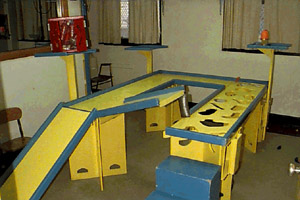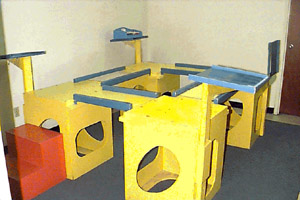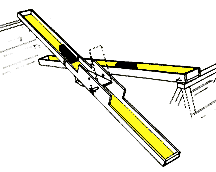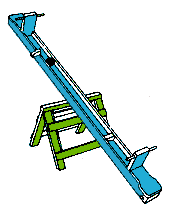Symbolic Playthings TM
The general purpose behind the use of various elevated board structures and devices is to develop increased body awareness, attention to surroundings, problem solving, perceptual motor coordination and the first steps toward meaningful communication.
Elevated Board Structures
The use of elevated board structures began when the Millers found that placing severely disorganized and developmentally delayed children on elevated structures 2.5 feet above the ground often resulted in immediate improvement in contact with people and surroundings.
They found that eye contact improved in part because the children were raised to the adult's eye level. The children also became better organized: Many who toe-walked on the ground walked with feet firmly planted when they were elevated.
Children unable to follow directions on the ground often began for the first time -- when elevated -- to respond to manual signs and spoken words.
Elevated SquareTM
The single most important structure which the Millers have designed is known as the Elevated SquareTM. Cognitive designs, Inc. builds two kinds of Elevated Square: One, known as Elevated Square A is for children from 18 months to 4 or 5 years of age;
the other known as Elevated Square B is suited for children from 18 months to 10-years of age.

The major difference between A and B squares lies in their support structures. Elevated Square A -- more lightly made -- is designed so that the square rests on 4 cross-shaped pedestals (see illustration below). Each pedestal can be disassembled and packed flat in a way that makes the square more portable and lends itself to travel.
Elevated Square B, on the other hand , rests on 4 sturdy cubes (see illustration) which -- when not used to support the structure -- may be

reassembled as part of the Honeycomb ArrayTM (see Honeycomb Array illustration)...Both Elevated Squares come equipped with various accessories including a set of velcro stairs which can be taken apart to provide obstacles on the square, with an Anticipation Board (see illustration) as well as "Swiss Cheese"
and Parallel Boards. Each square also includes adjustable stations on each corner of the square for fine-motor work as well as a slide attachment. Each square also includes removable connectors so that the child can be taught to make detours when the usual means of going from one point to another is no longer available.
A video demonstrating the use of the Elevated Square comes with each purchase.
The Honeycomb ArrayTM consists of a group of 4 to 6 carefully designed boxes which can be arranged in various configurations to challenge the child's body organization and perceptual-motor functioning. Each box has variously shaped holes on three sides through which children can climb either through one
block to another or from a lower to a higher block. This enables a teacher with one or two aides to work with a group of from 4 to 6 children at the same time. The children also can walk on top of the Honeycomb ArrayTM and go through the Bump BoxTM and the Problem BoxTM
(see illustration). They are also able to attach a rope to a remote Honeycomb box so it can be pulled closer to fill a gap between two other boxes so that a child can walk across (see illustration).
A price list detailing the cost of Elevation Squares A and B and the Honeycomb Array with all accessories is listed on the order form.
Interaction Devices
An important part of a child's cognitive and emotional development entails the formation of an inner life capable of representing everyday experiences in play. Certain highly structured modes of play have been helpful in leading to more spontaneous play among exceptional children. To bring about spontaneous play the Millers recommend beginning with highly structured play relationships and, as these are mastered, to introduce progressively less structured relationships. A few of the devices developed for this purpose are listed below.
Interaction Ramps
This arrangement of two ramps attached to each other allows 2 to 5 children to play with each other in a highly structured manner. When 2 children are involved, a child at one end sends a car (or ball, skate, toy train, block, etc.) down one ramp and then, as it is returned by the child on the other side, stoops down to pick it up and repeat the procedure. Teachers, as required, help the children perform the desired action while remaining sensitive to the child's increasing tendency to anticipate and perform the sequence himself. When five children are involved, one child is stationed at each end of a ramp and one child operates a switch in the middle of a ramp. Then, one child sends an object to a child waiting at the bottom of the ramp. This child then picks up the object, turns toward and gives it to the child standing next to him who, in turn, sends it down the ramp where it passes the child operating a switching arrangement which allows objects to either go over or under an internal ramp. Further, a slit in the side of the apparatus allows the introduction of a thin board making it possible for an object to stop or go.

After each child has experienced a particular position, the teacher may decide to have the children move clockwise to the adjacent position. Thus, a child stationed at the bottom of the ramp would move to the switching position while the former switch operator would move to the top of a ramp, etc. A variant of this structured play, suitable after the children have experienced all positions on the ramps, is to have the ramps used to send "needed" materials. Thus, if a puzzle is being completed on one side and a block structure on the other, and the children on each side of the ramp have the materials needed by children on the other side, each child may call for the materials e.g., "blocks" . . . "puzzle" they require (although teachers may first have to prompt this exchange).
Interaction See-Saw
In addition to the obvious physical interaction as each child shifts from down to up position, this see-saw includes a channel which allows a wooden ball to roll back and forth each time the see-saw goes up and down. The sound and motion of the ball guide the child's vision to the other side of the board where the other child sits. Later, the hinged trap at each end of the see-saw makes it possible for a child to either stop or let go the wooden ball. This may be done by either closing or opening the hinged barrier placed within reach of each seated child. Thus, in addition to furthering awareness of another, the interaction see-saw makes available concepts up, down, open, close, stop, go.

Flower TableTM with Stools
Although this table and its stools were specifically designed to help easily distracted to withdrawn children relate more readily to each other and their teachers, it is suitable for any pre-school nursery or kindergarten setting. Each aspect of the table-chair design has a specific purpose. For example, the 5 bay indentations bring each child more directly into relationship with each other. Without these bays, children tend to spin off the circumference of a round table. The bays also provide opportunity for the teacher to work directly behind each child in a way which precludes the child from straying from the task at hand.

The stools were deliberately designed without backs after observing how readily many withdrawn children would retreat from learning situations by leaning back in their chairs. Options include a) tables with 4,5 or 6 bays as well as b) a "Lazy Susan" top that allows different materials from other locations on the table to be rotated in front of a seated child.
| 
